site search
online catalog
RARE IDENTIFIED 65th NY SERGEANT’S JACKET, WITH MANSCRIPT MATERIAL: 1st U.S. CHASSEURS
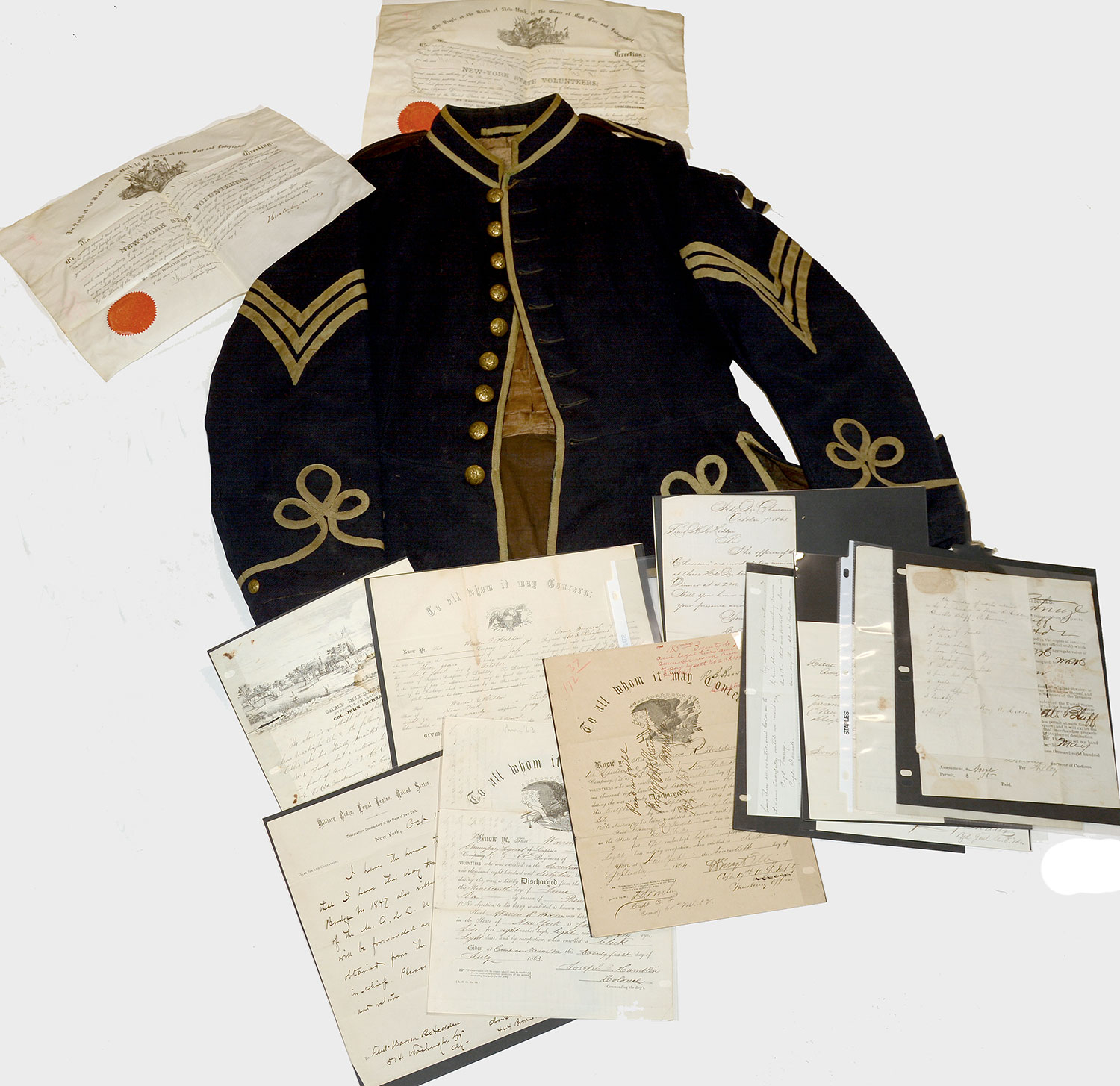
Hover to zoom

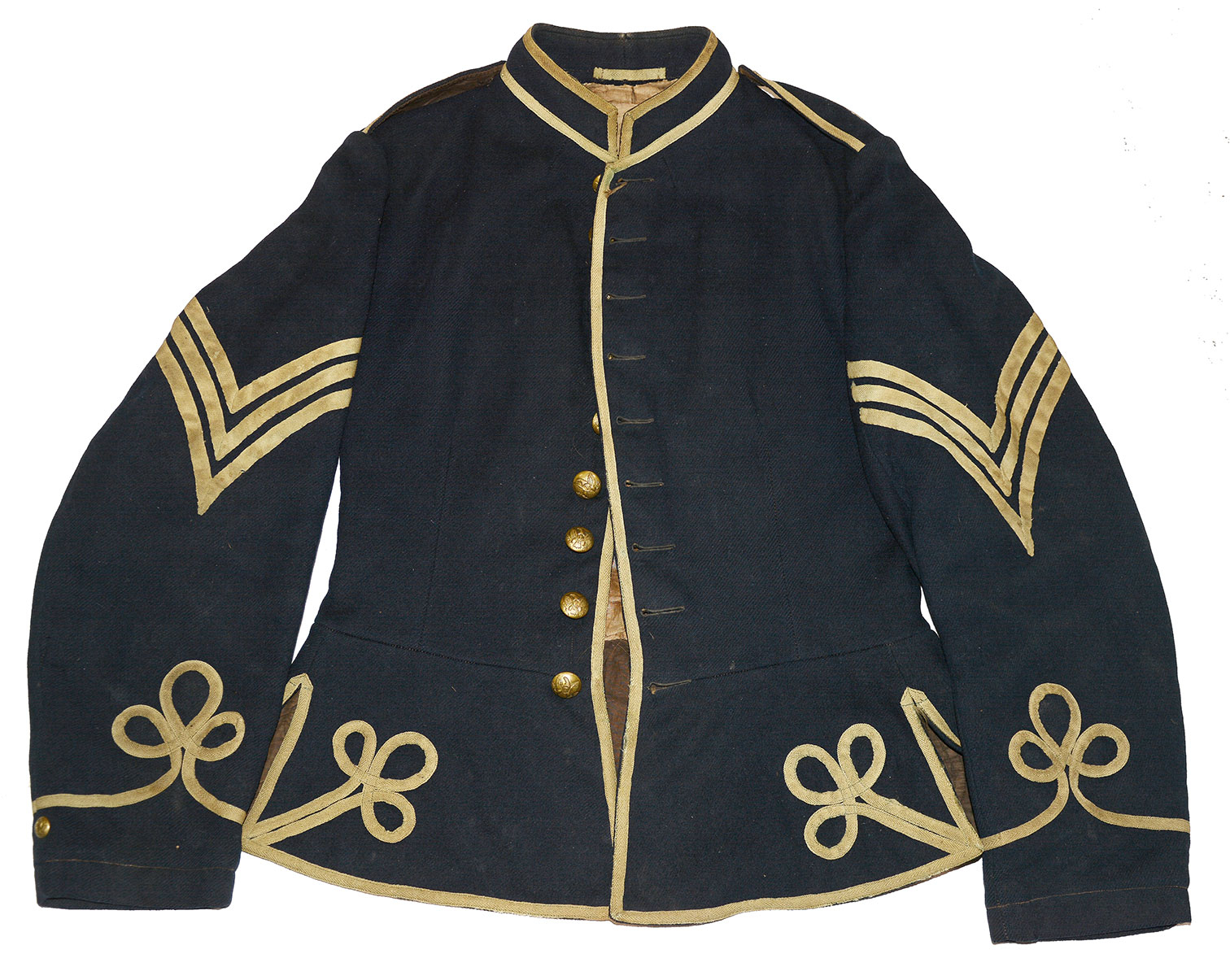
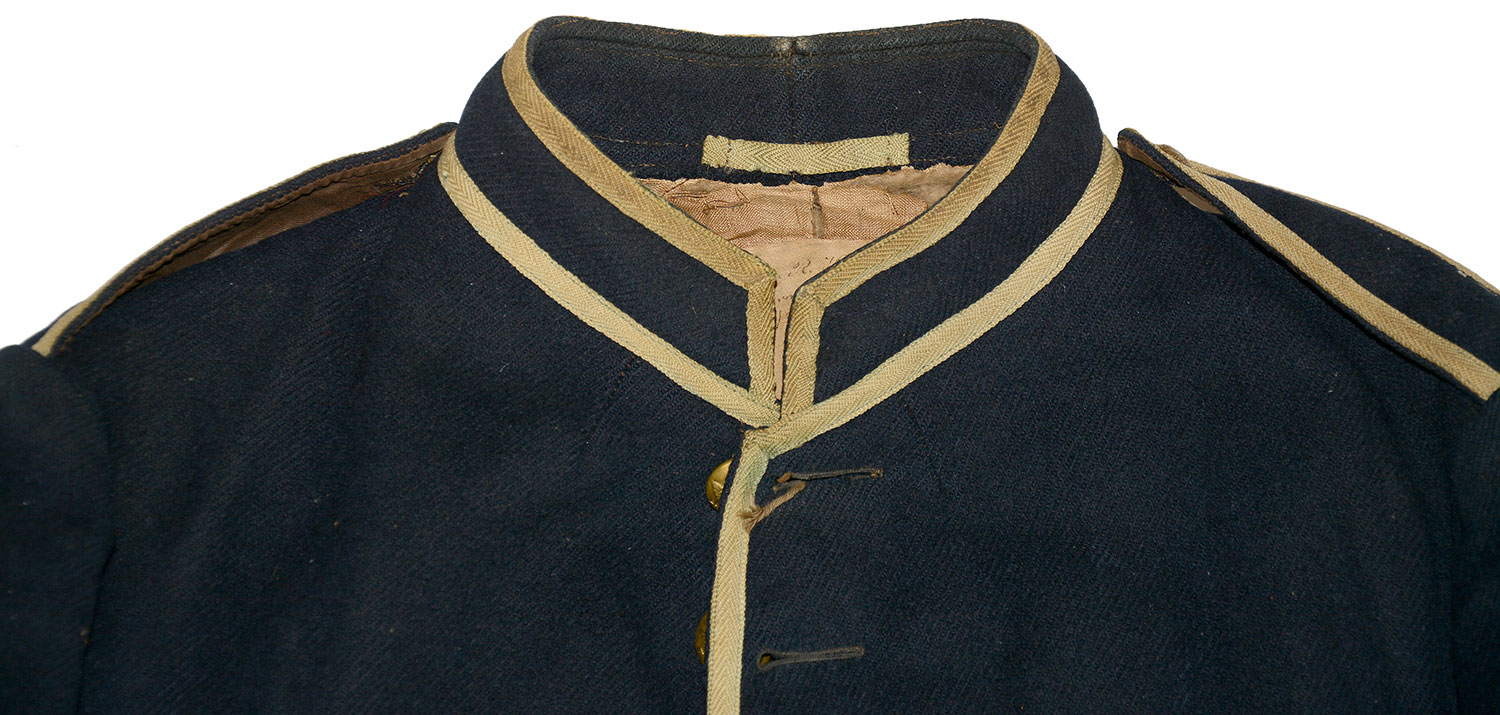
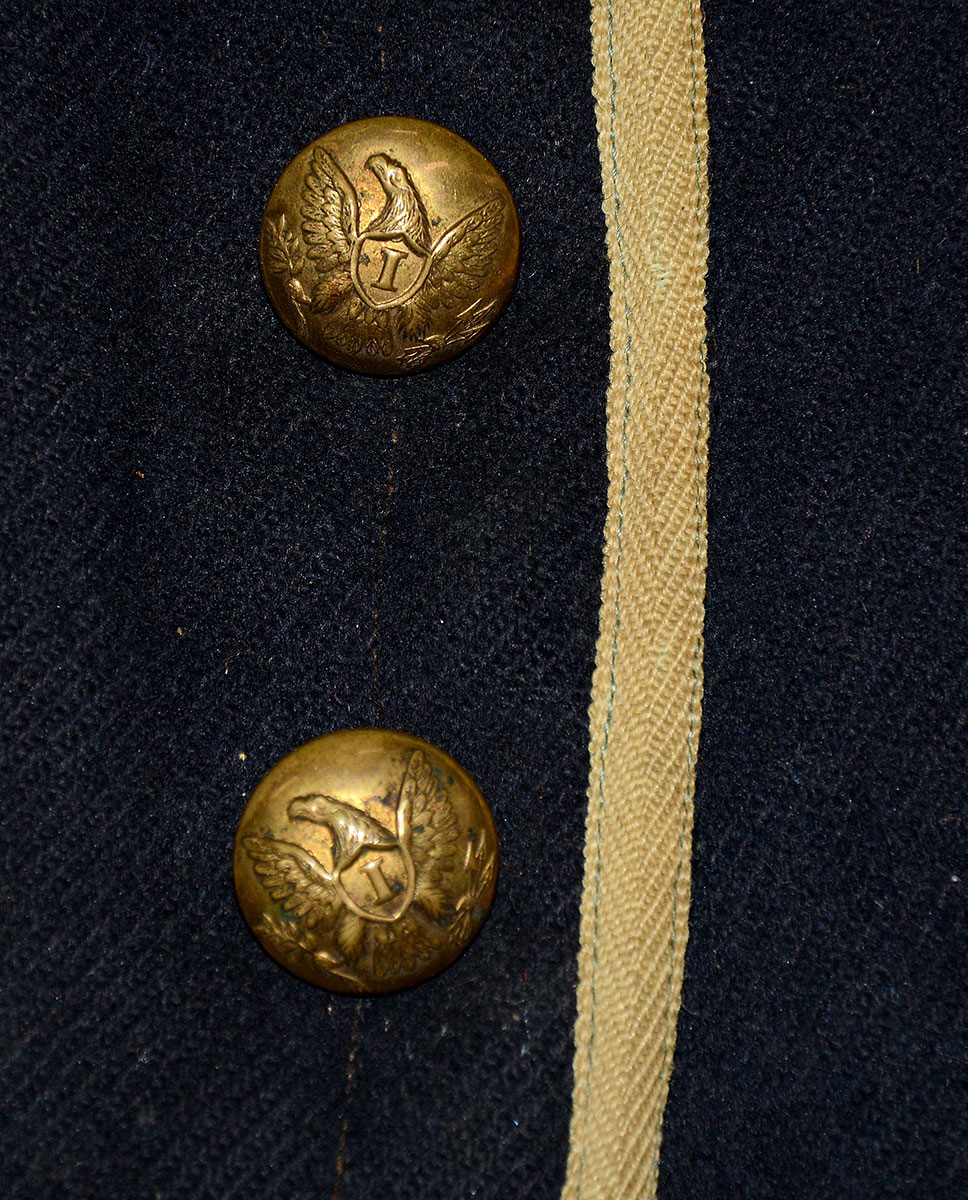
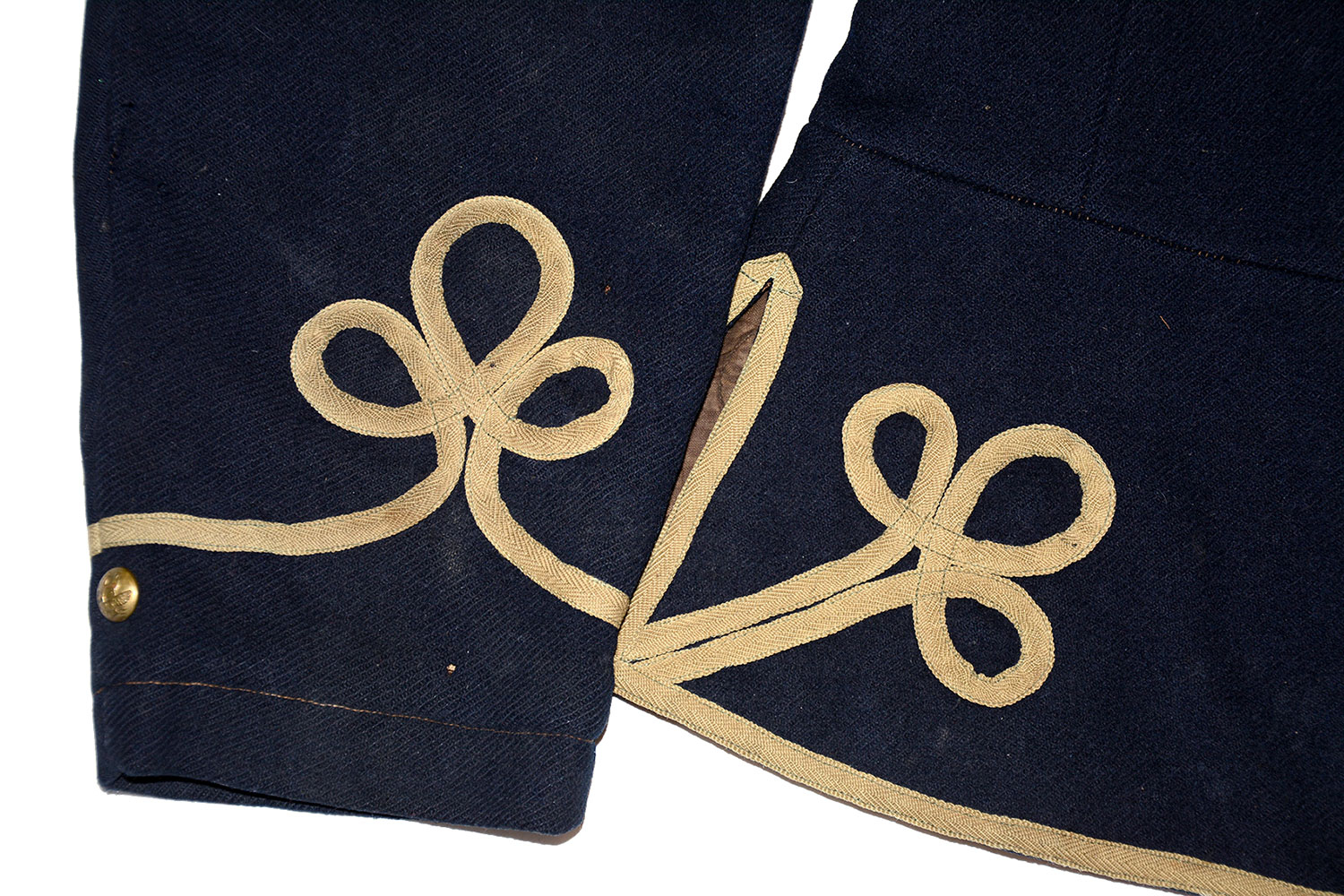
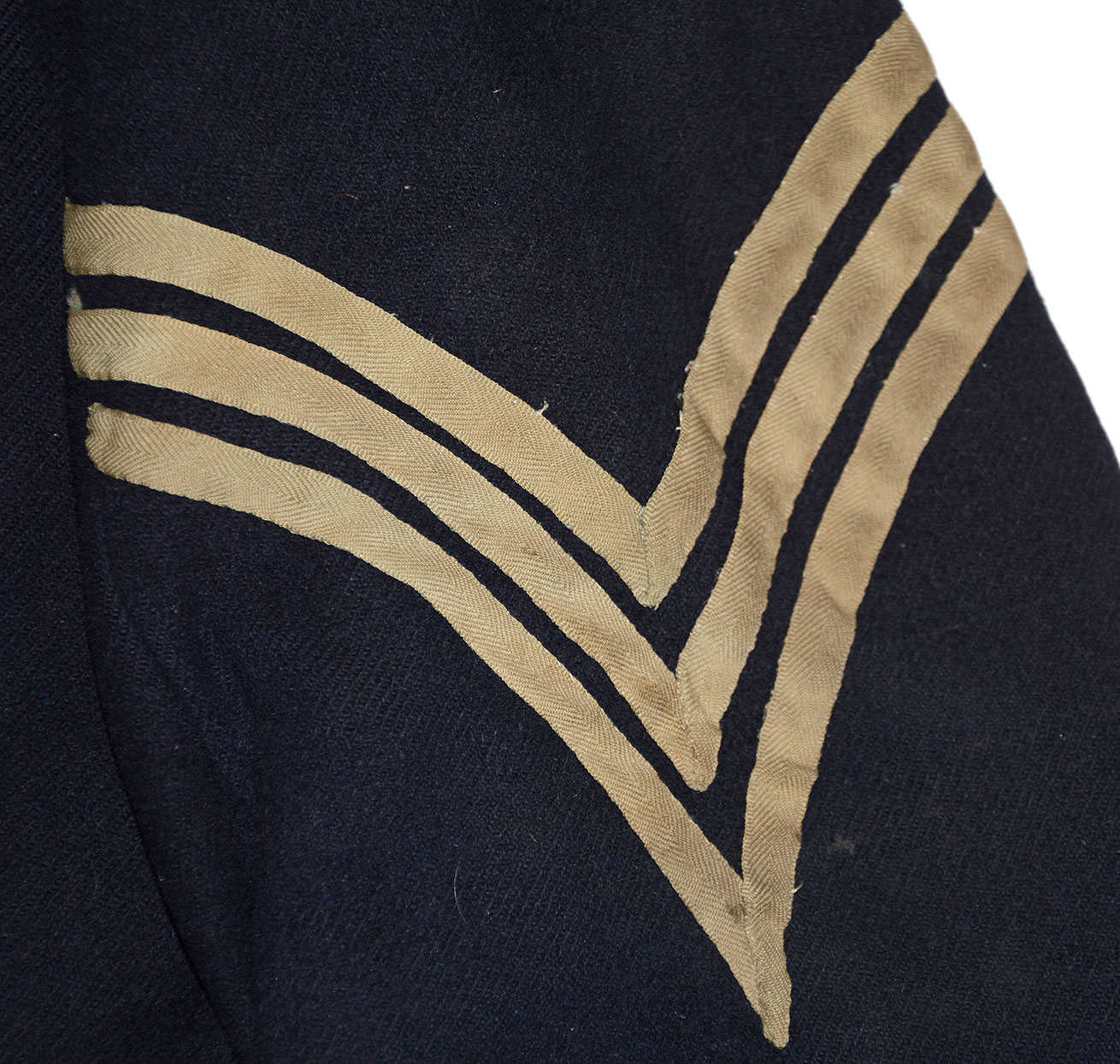
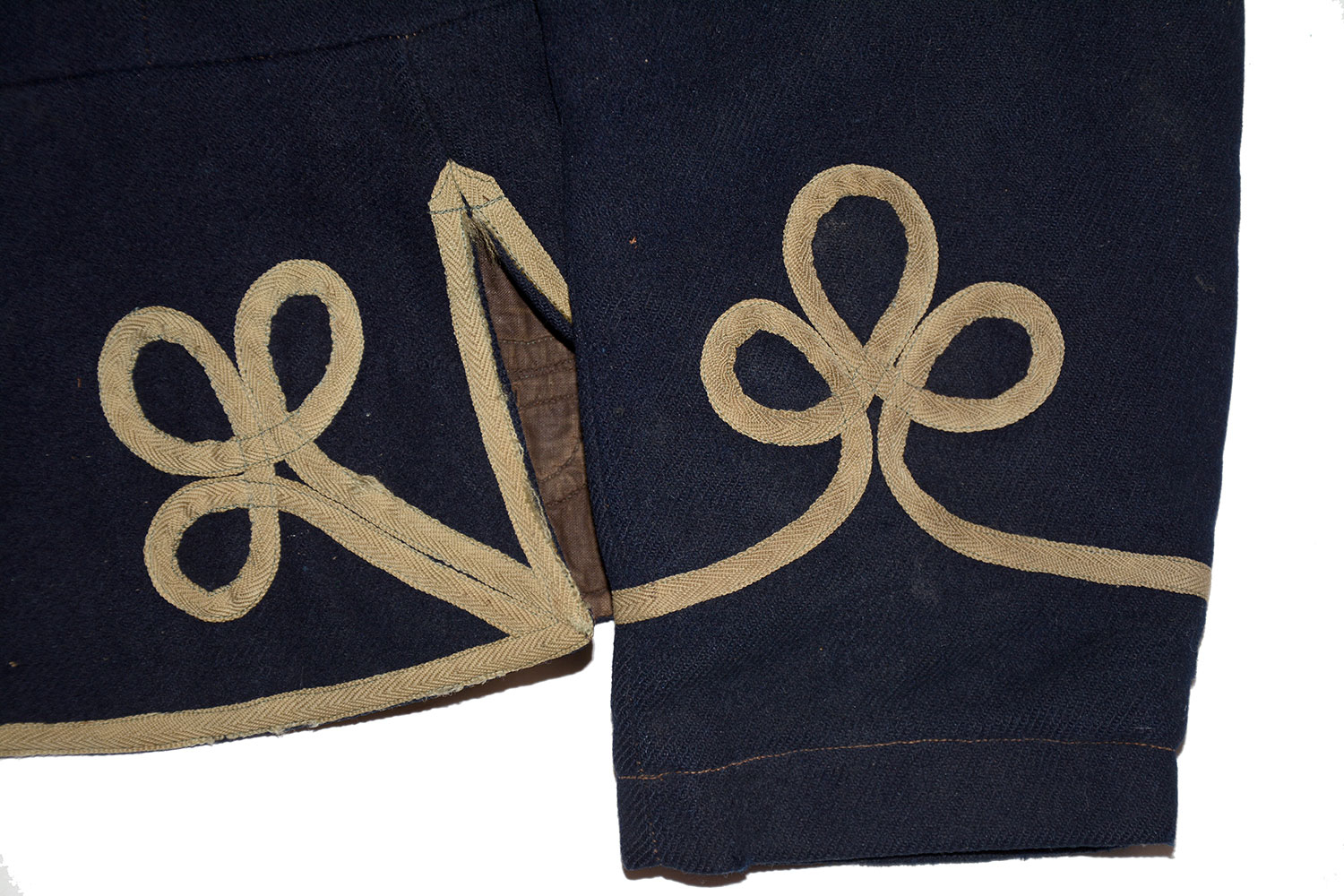
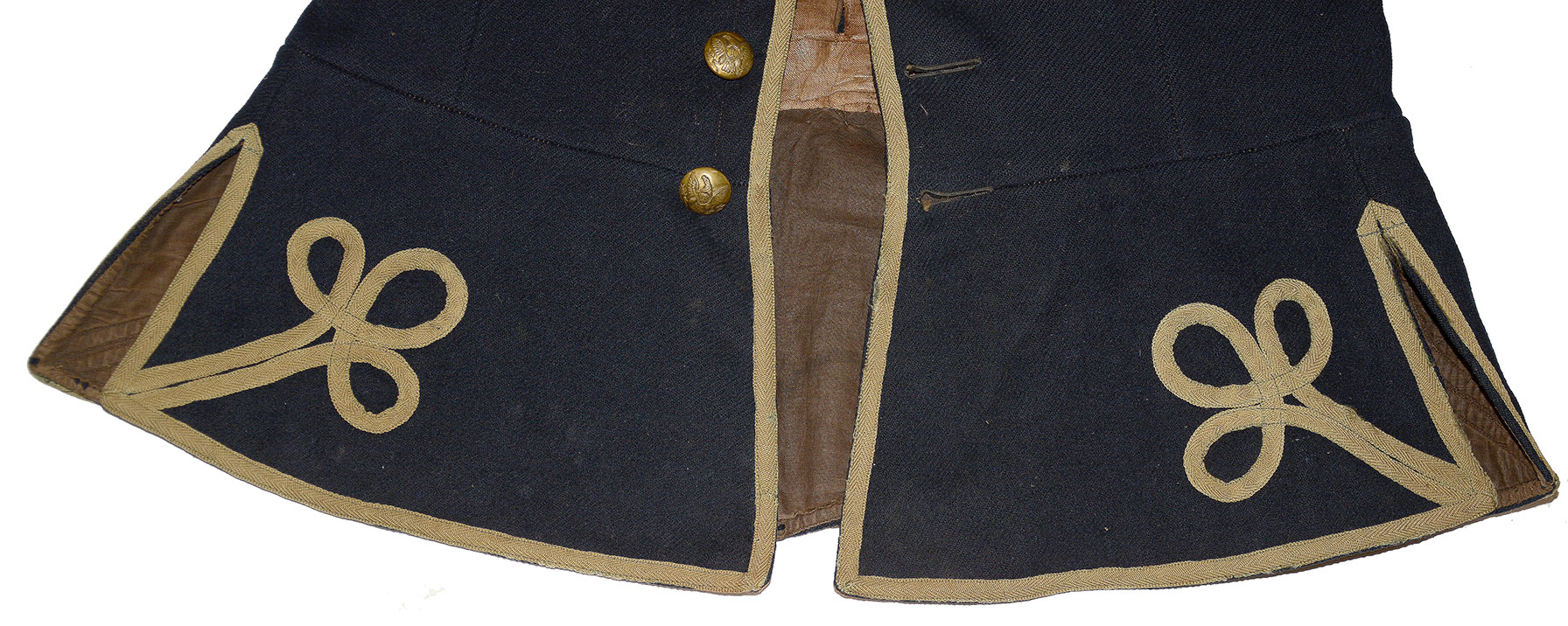
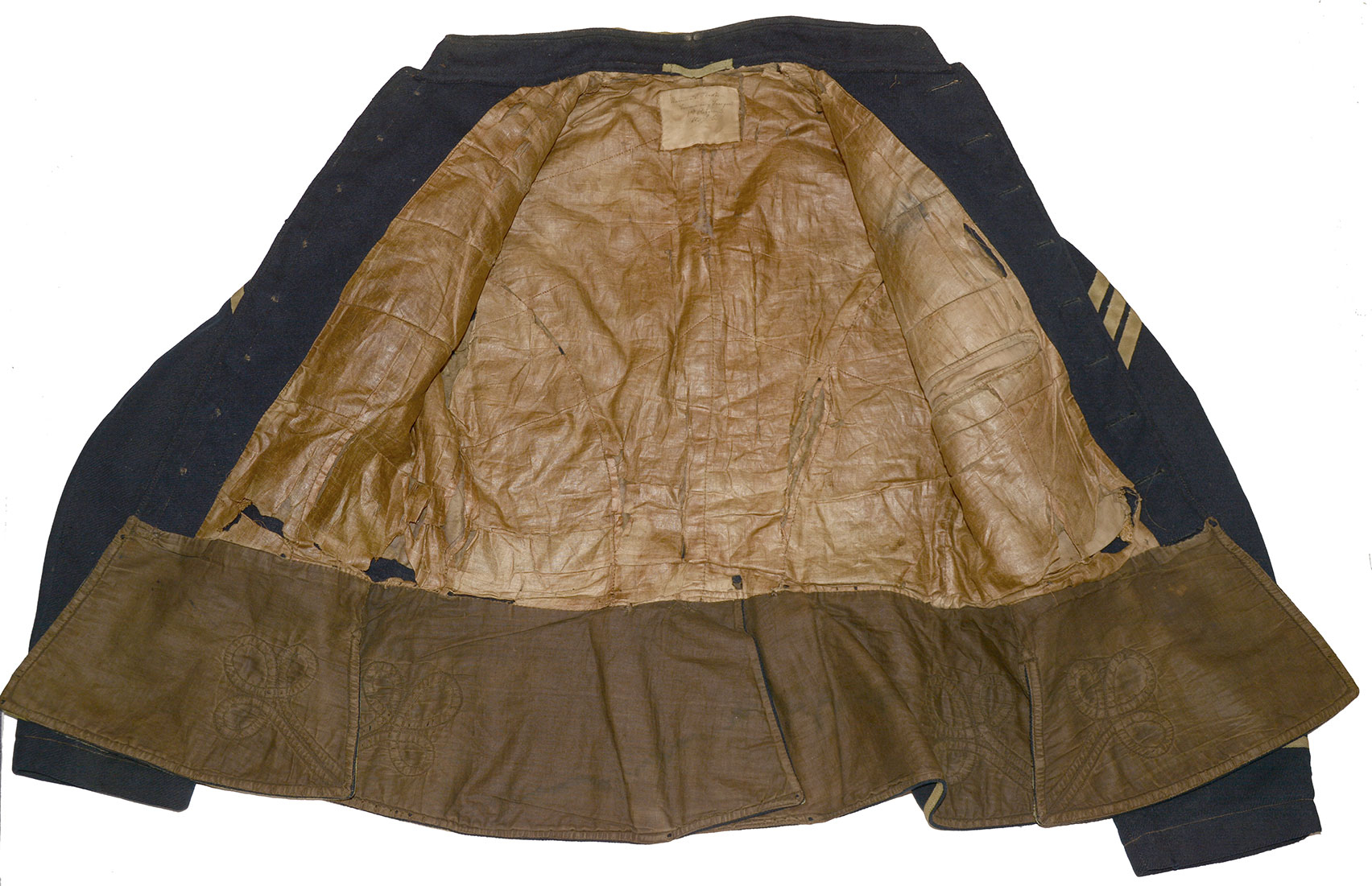
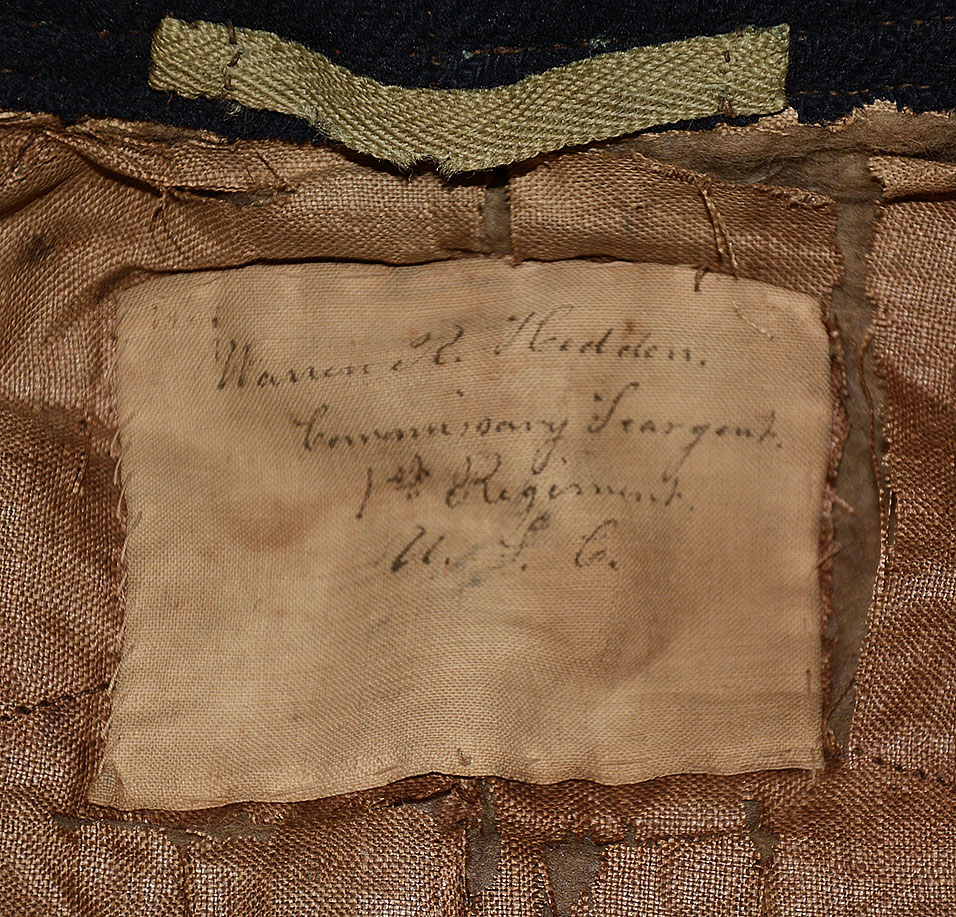
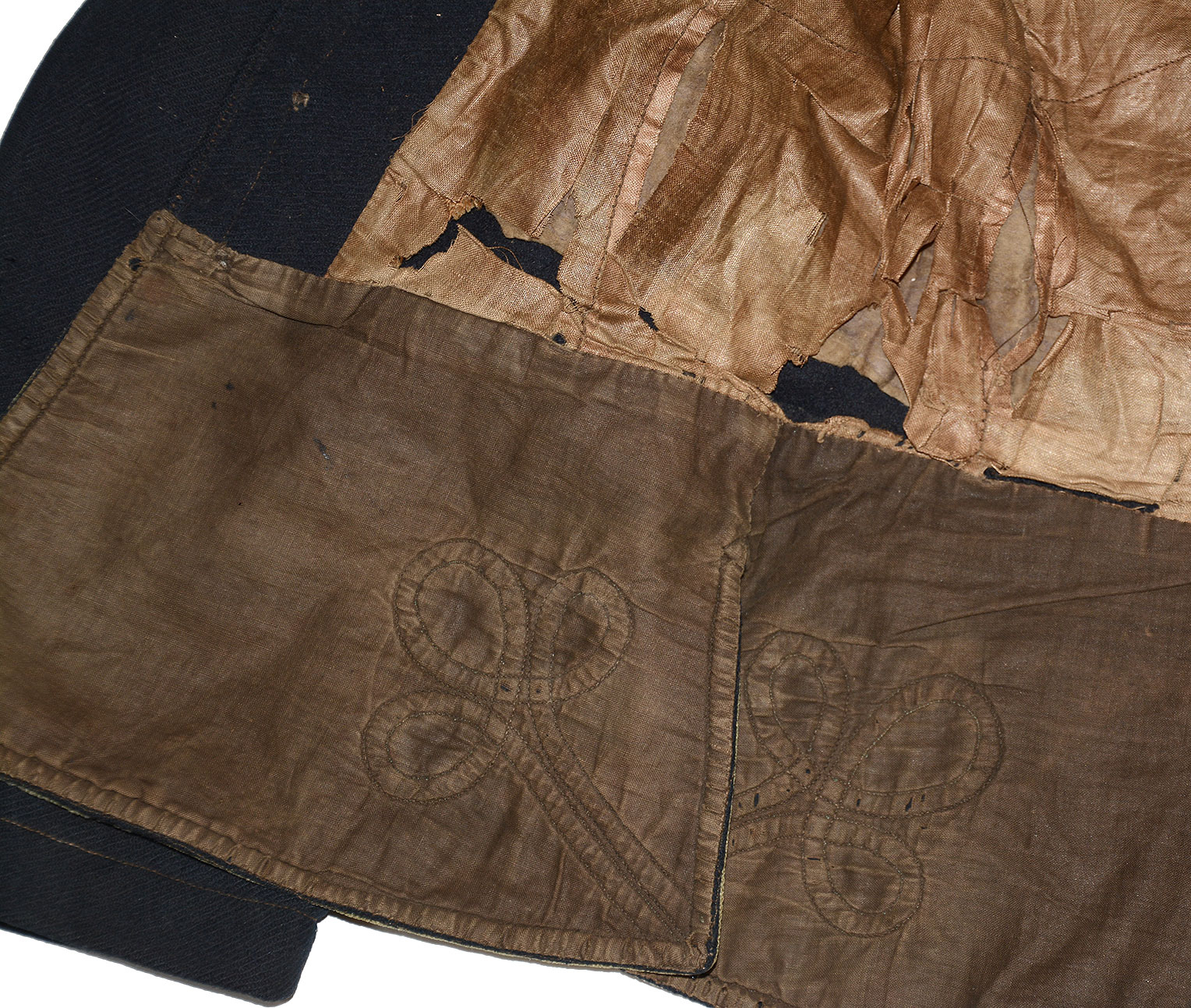
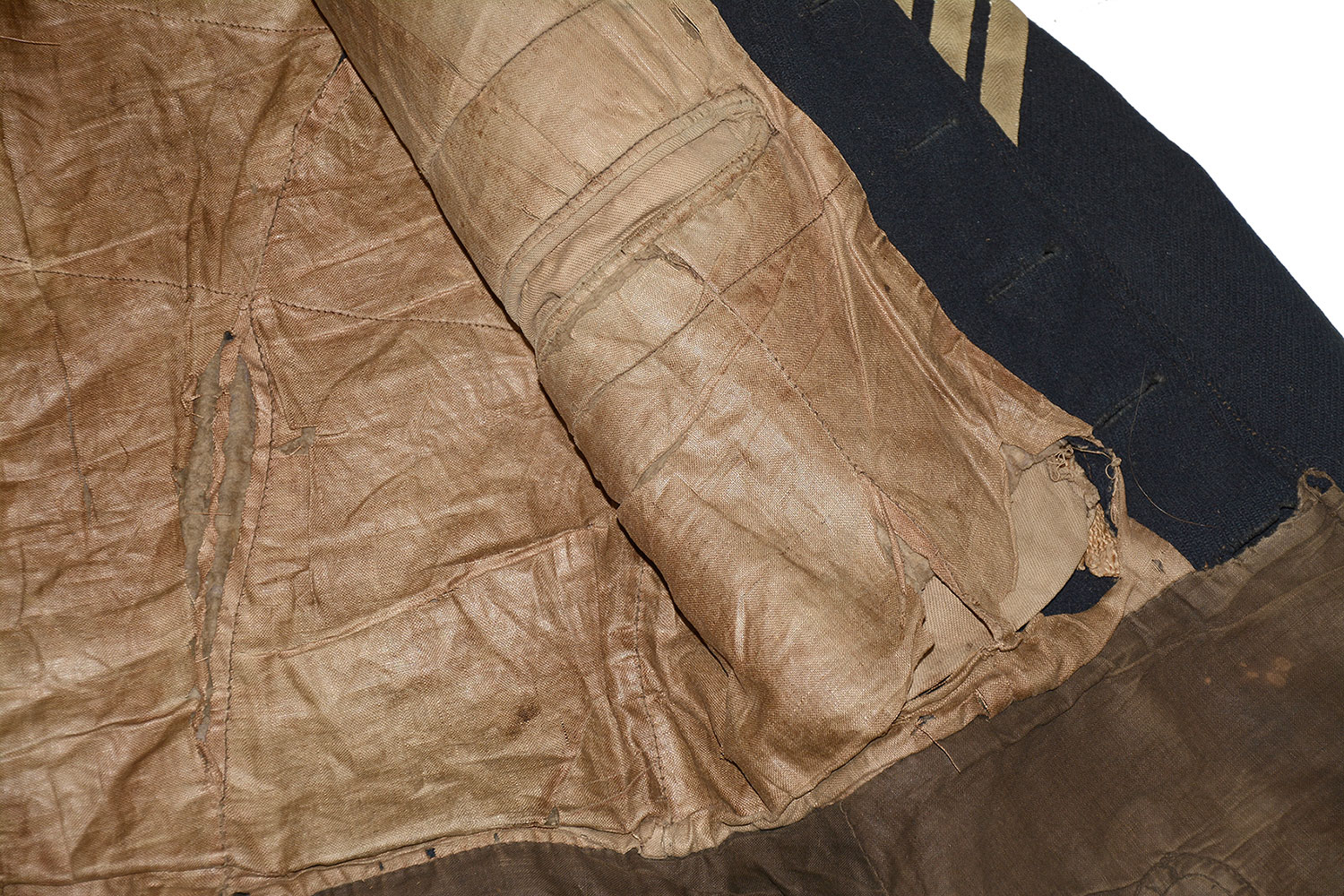
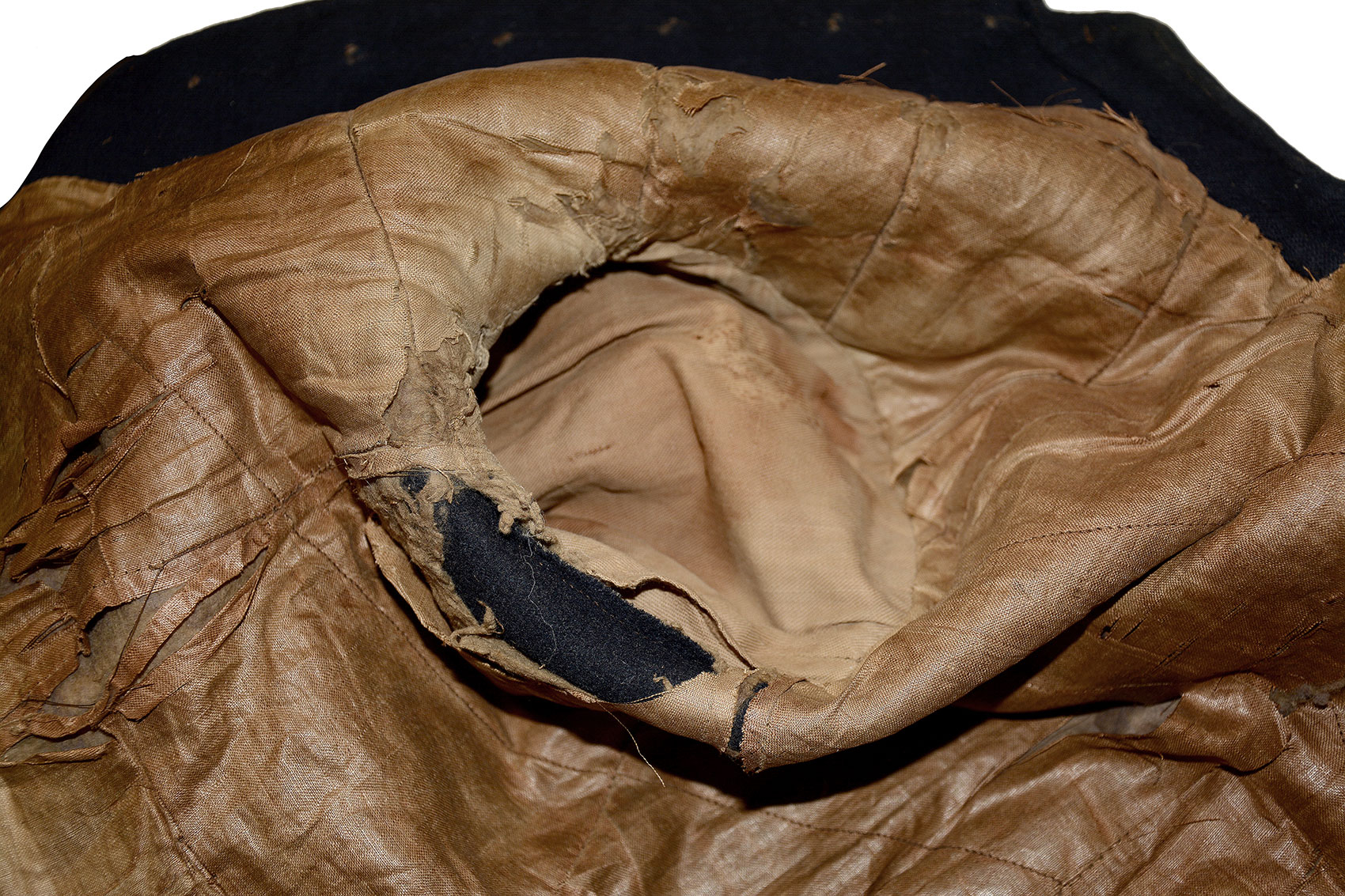
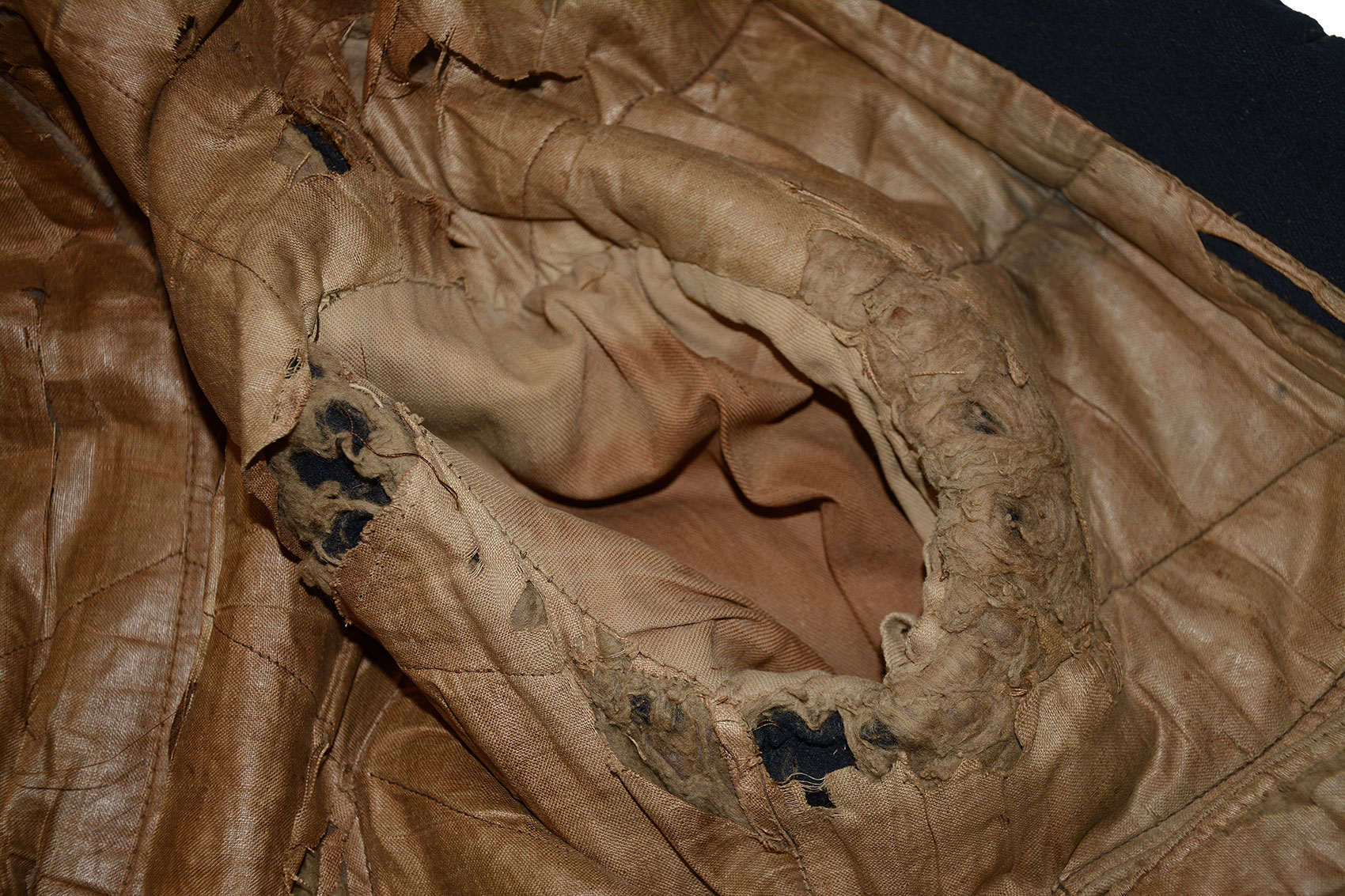
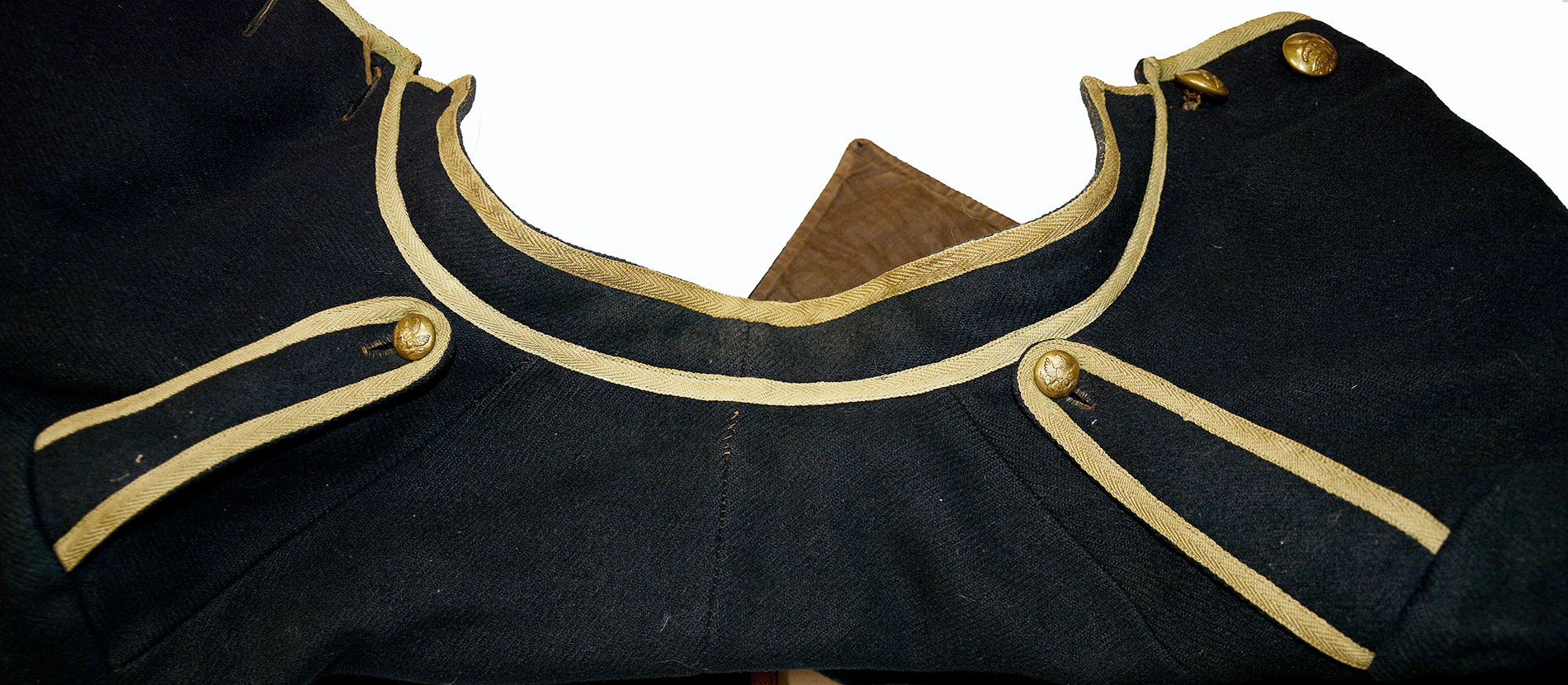
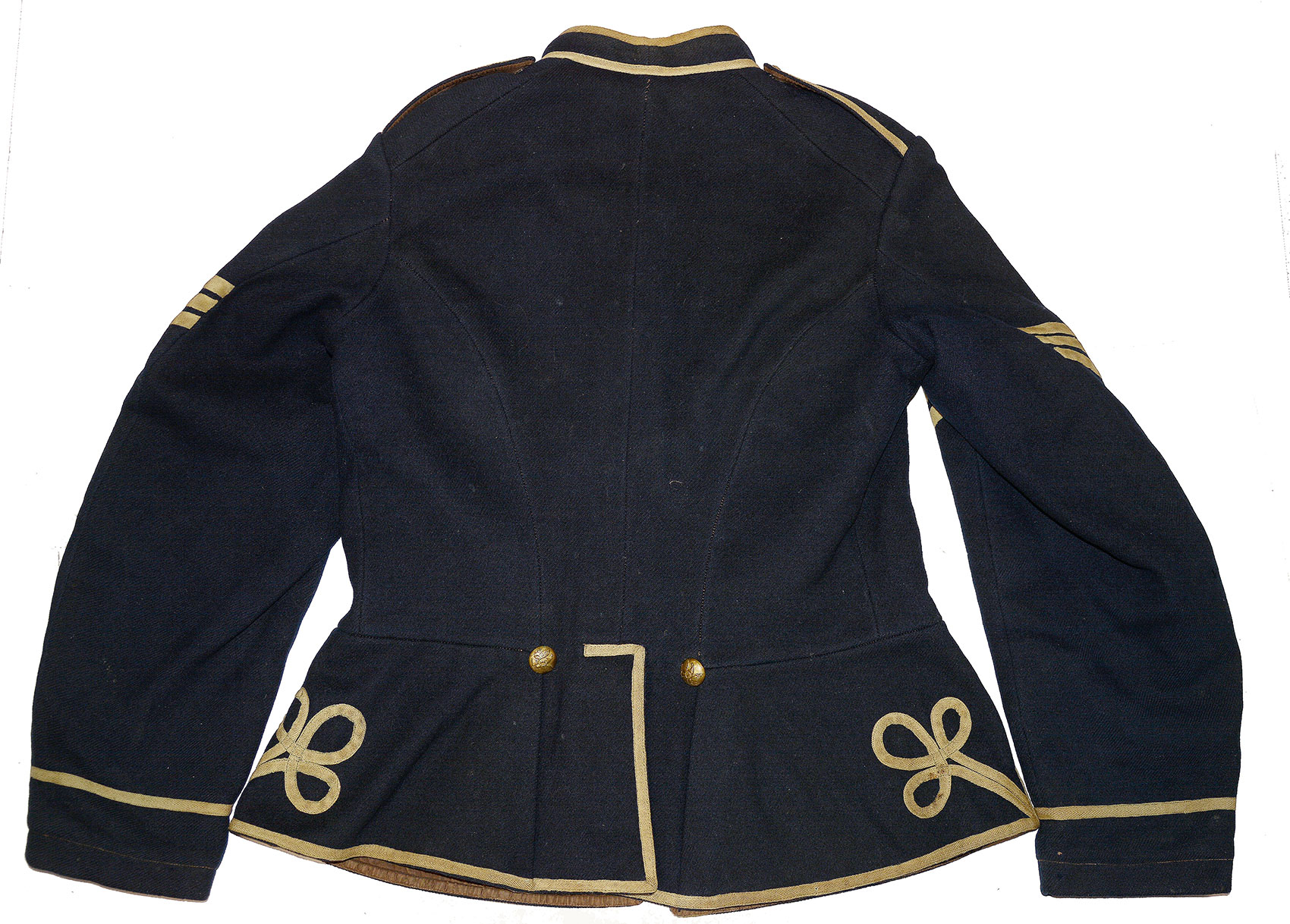
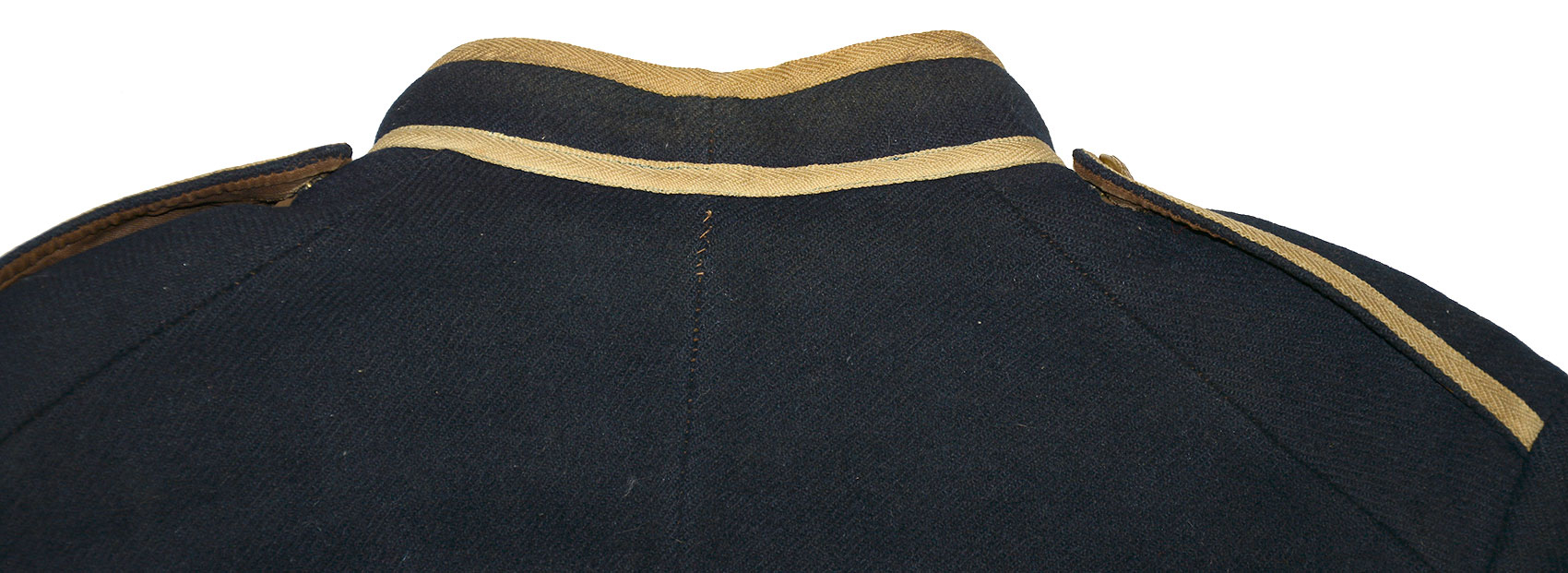
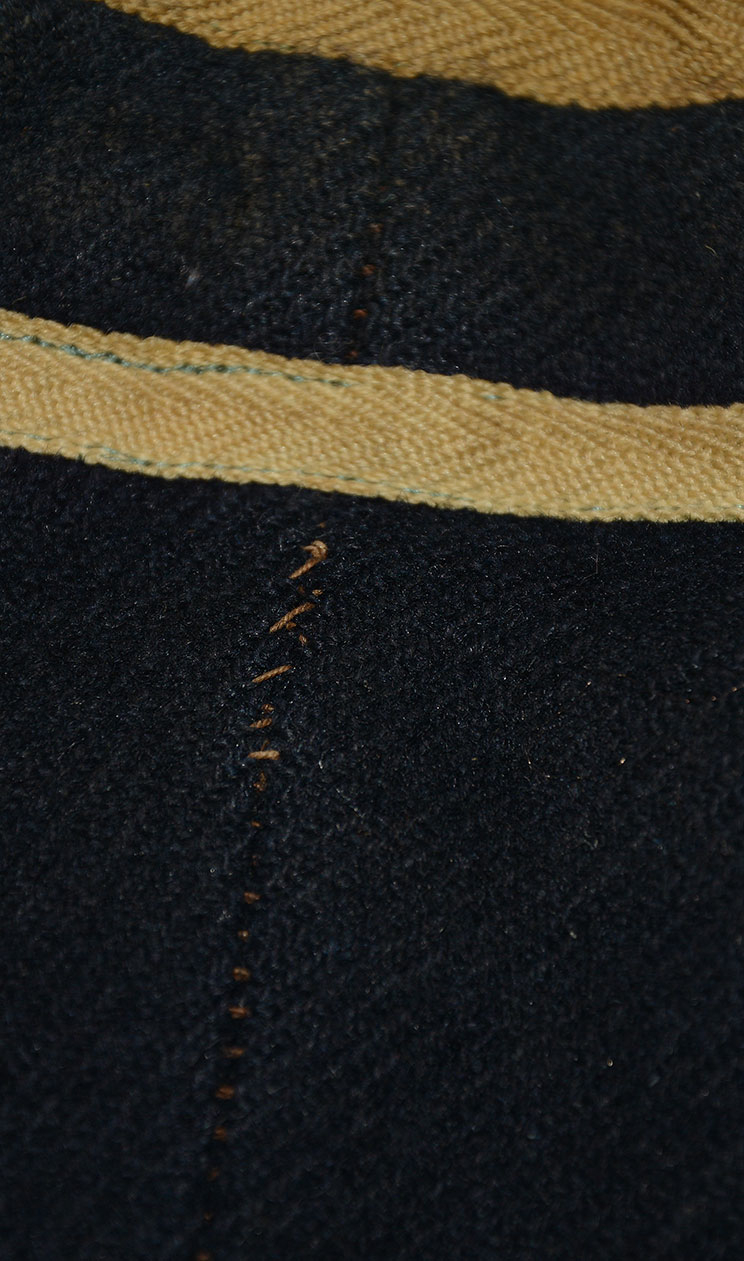
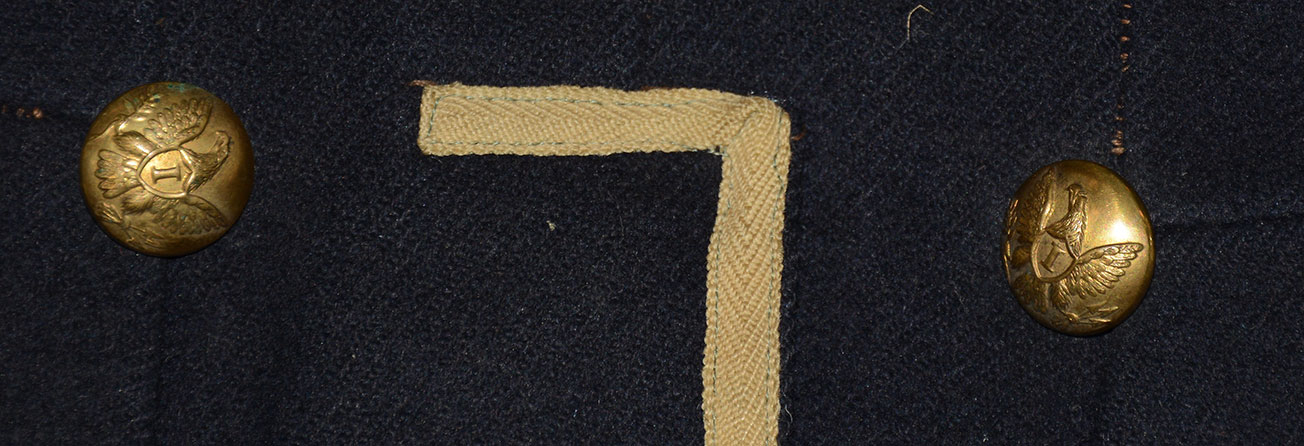
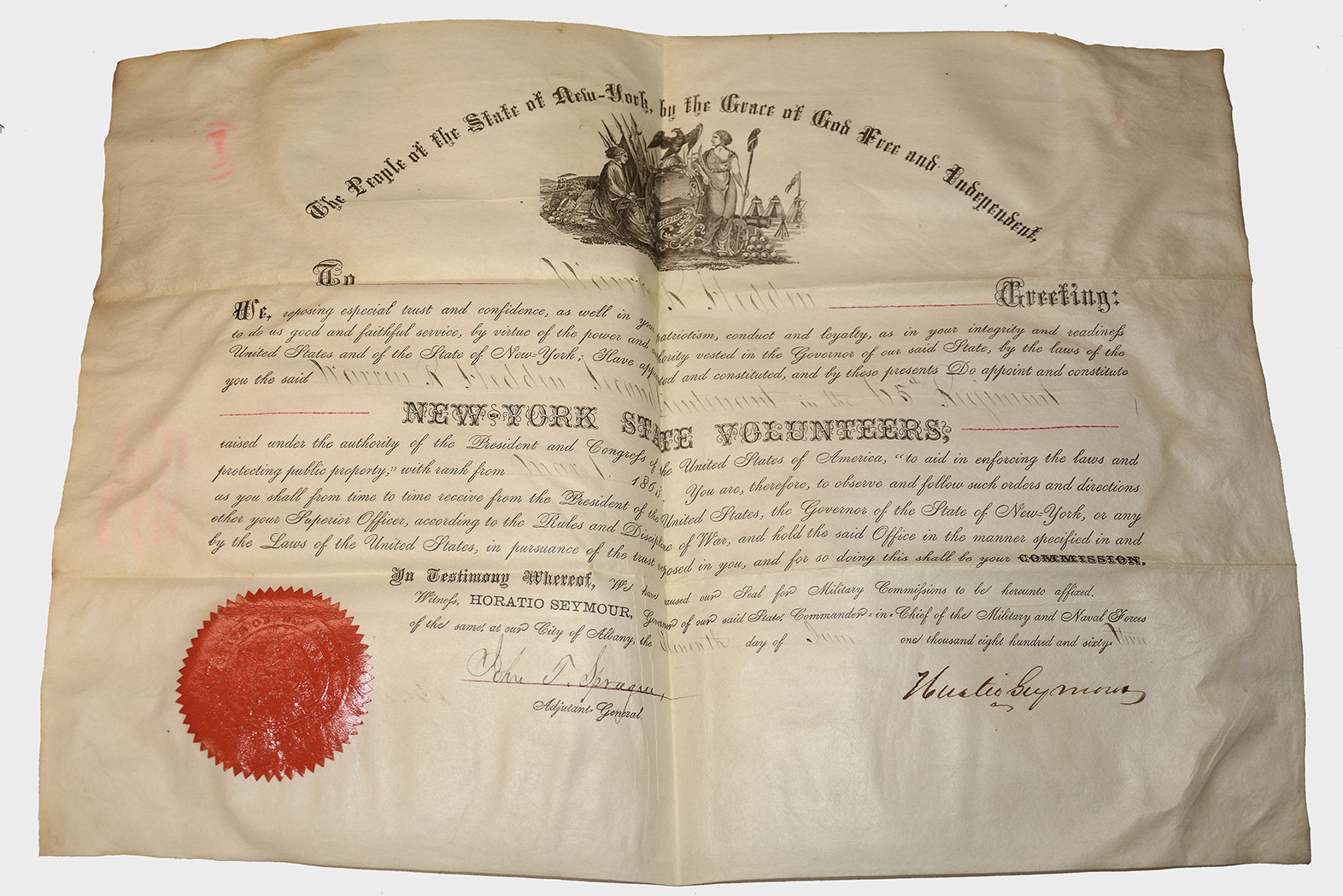
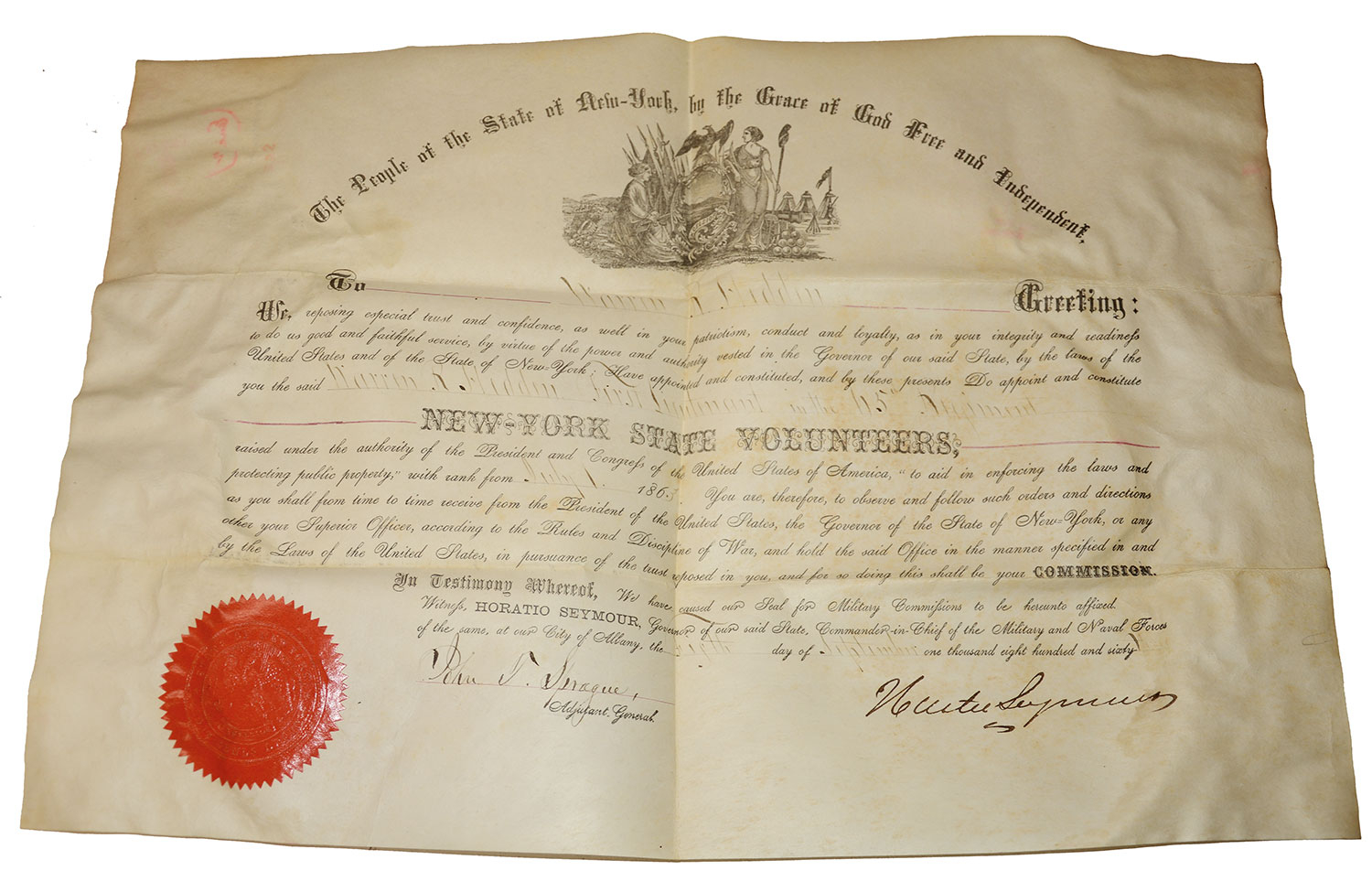
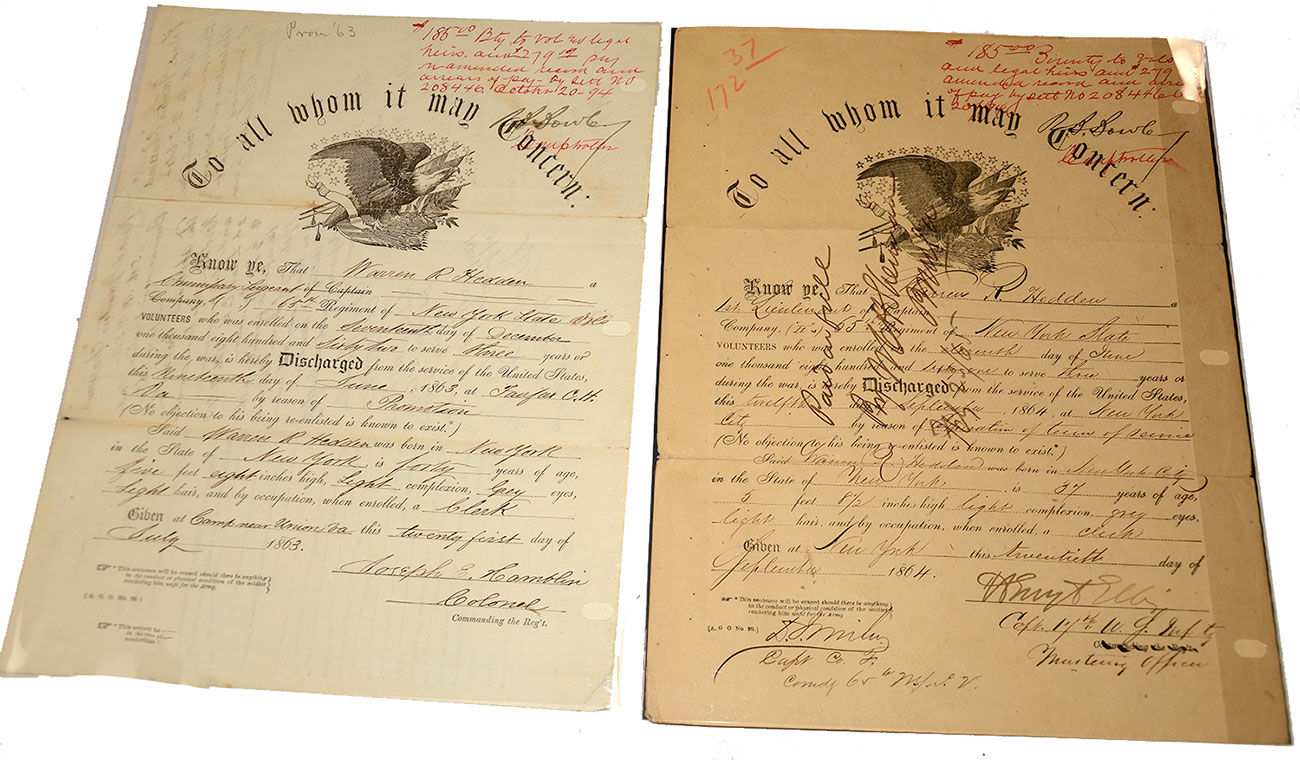
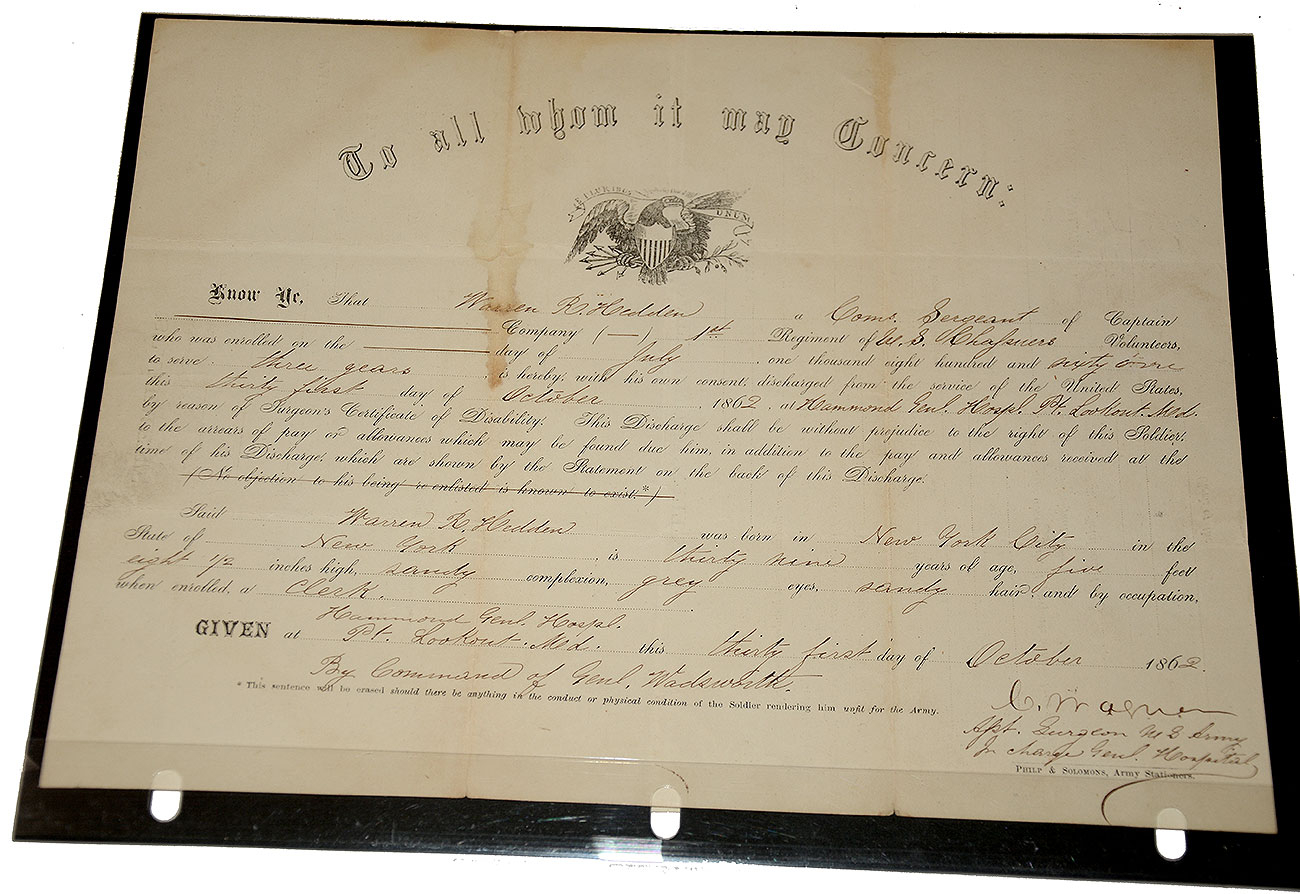
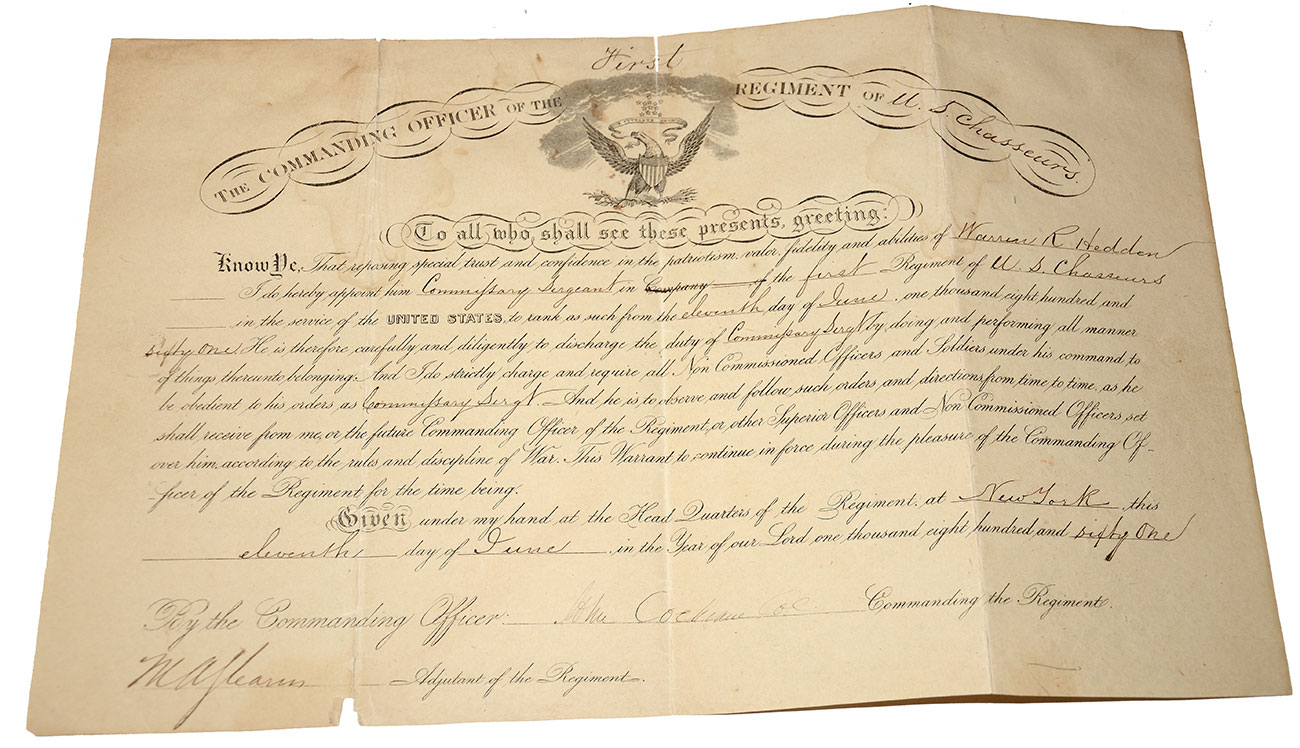
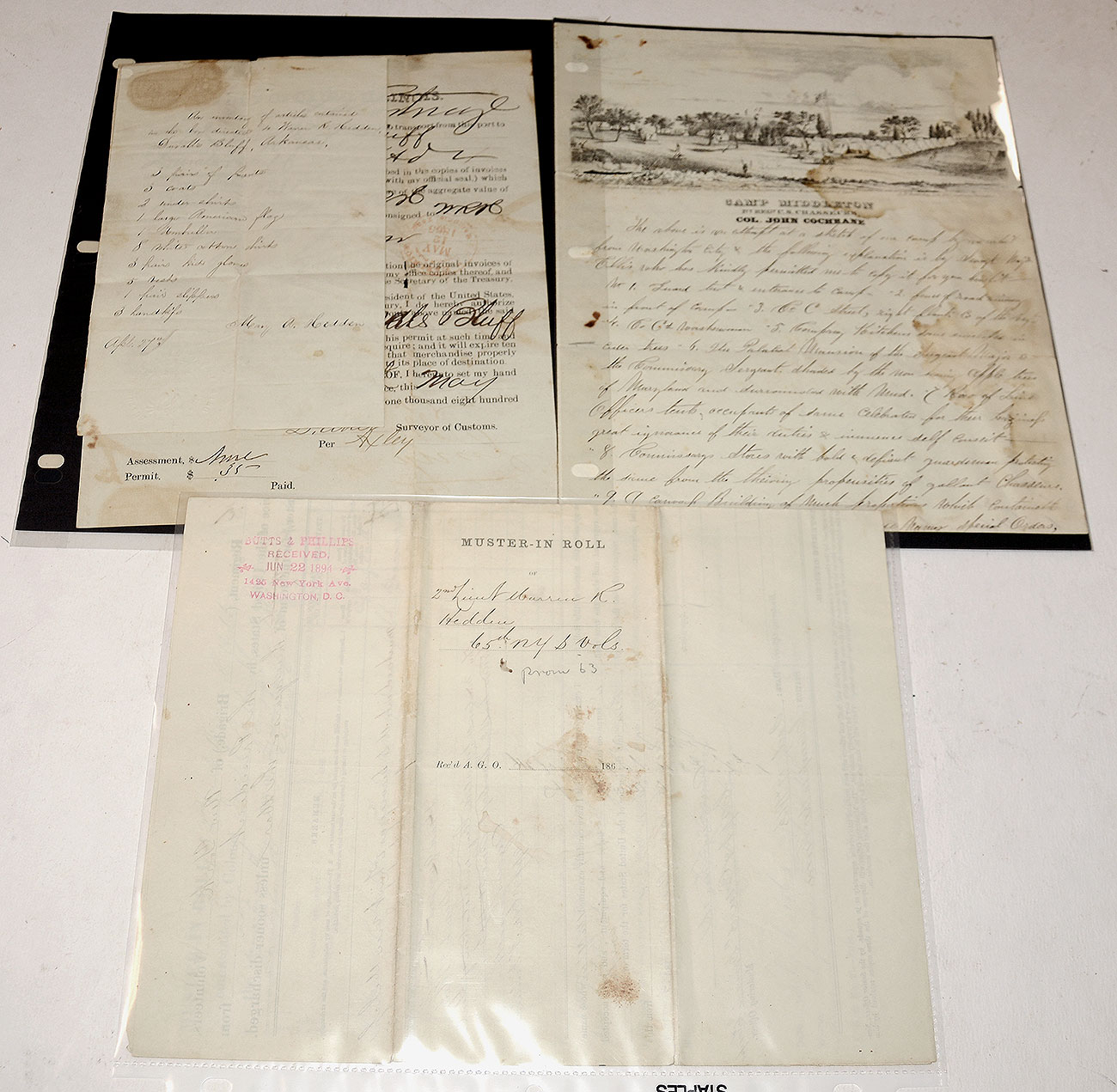
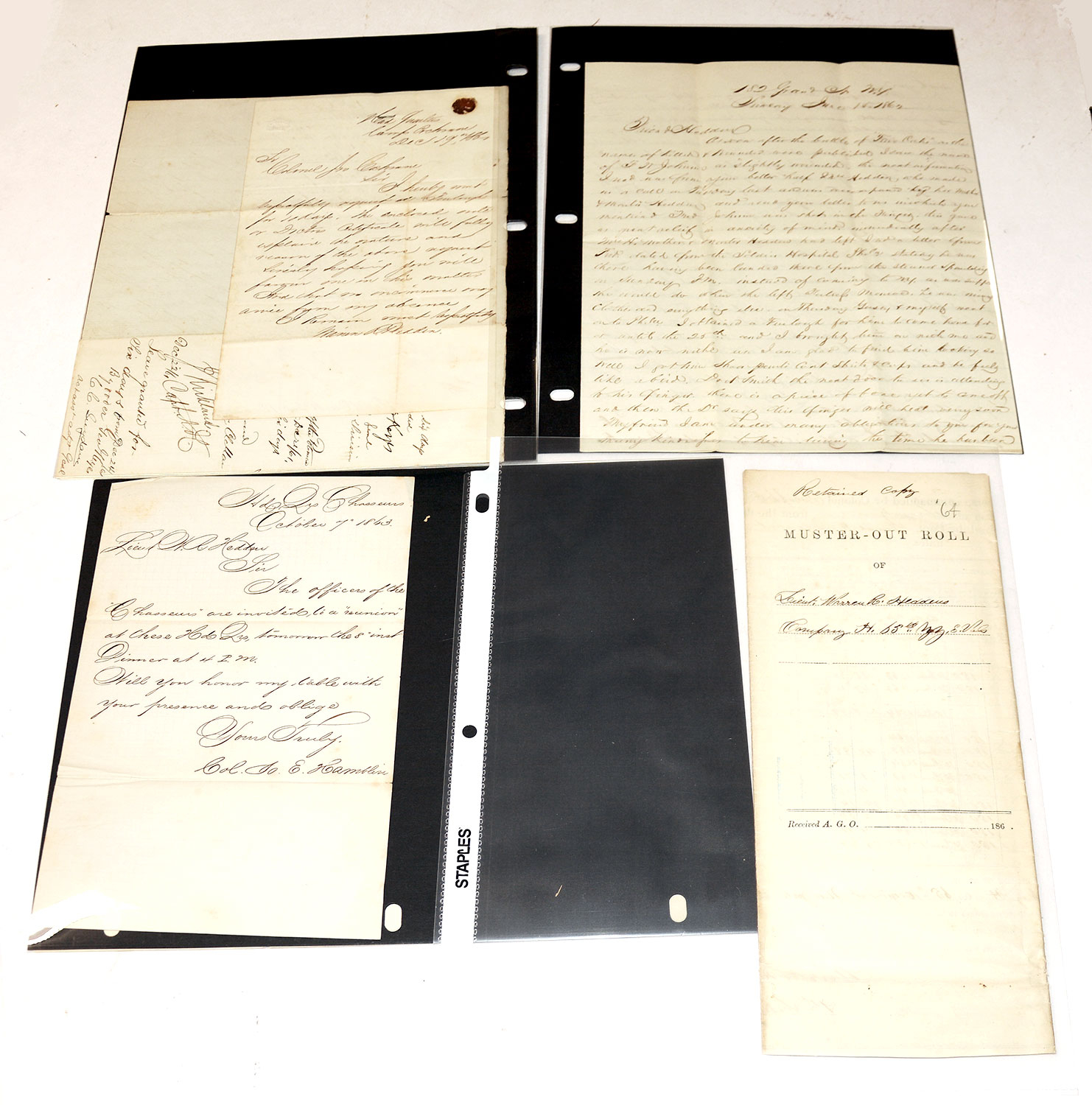
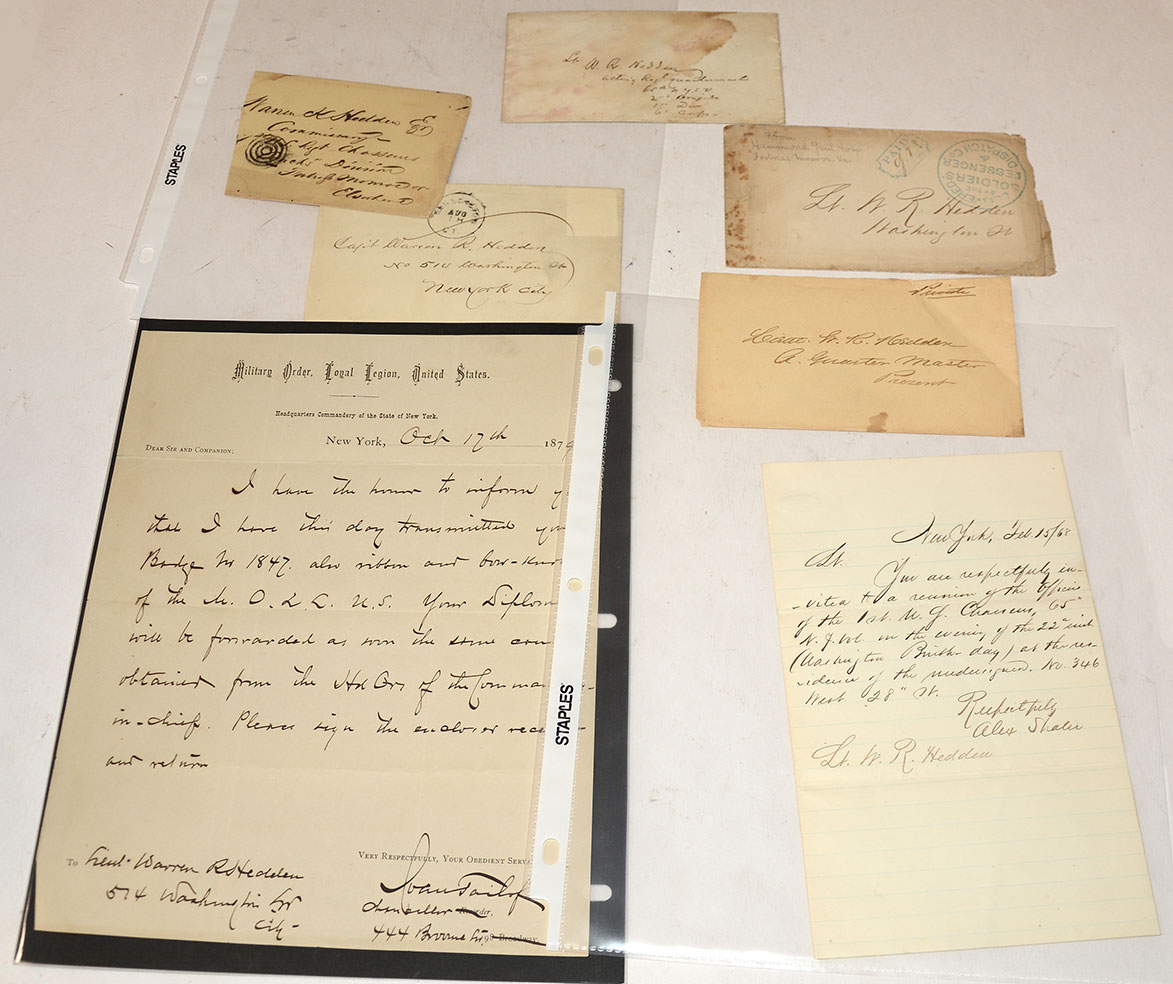
$22,500.00
Quantity Available: 1
Item Code: 1179-233
Shipping: Determined by Method & Location of buyer
To Order:
Call 717-334-0347,
Fax 717-334-5016, or E-mail
This is an extremely rare, early-war uniform jacket, with related material, belonging to a sergeant of the 65th New York, who enlisted at the beginning of the war as the regiment’s commissary sergeant, and gained a lieutenant’s commission in a line company early in 1863, serving until his muster out in September 1864.
The jacket is a chasseur style, a popular pattern in keeping the trend toward light infantry, patterned after the uniforms of the French chasseurs-a-pied, adopted by several New York regiments, and even recommended at one point for the whole army. The jacket is dark blue wool with short skirts slashed at the sides. It is trimmed with worsted wool tape along the top, bottom and front edge of the collar; down both lapels of the single-breasted front; around the shoulder tabs; around the lower edge of the jacket and up the vent at rear center. The trim also extends up an around the slashes at either hip and angles upward from the bottom of each of those slashes to form a trefoil fore and aft. The same trefoil loops are formed by trim running just above the cuff. The same worsted wool tape trim is used to form well-executed sergeant’s stripes on the upper arm on each side. The front is fastened by 9 coat-size eagle infantry-I buttons, with a small one on each cuff and shoulder tab. The regiment’s quartermaster sergeant is shown wearing the same pattern jacket in Time-Life, Echoes of Glory: Arms and Equipment of the Union, as well as in Ron Field’s Uniforms of the Union Volunteers of 1861: The Mid-Atlantic States. Although commissary sergeants often wore the same chevrons as quartermaster sergeants, the practice was not universal and, in this case, Hedden’s chevrons are the same worn by company sergeants.
The dark blue wool retains excellent color. The trim was originally light blue, but has faded to an off-white from age and exposure. The original color shows faintly on the top of the right lapel, which would be protected by the overlapping left, even if worn with just the upper button fastened, and is also readily apparent on the thread used to secure all the trim. The same color-shift is evident on the trim of other jackets with real field use: see, for instance, the two identified jackets on page 125 of Echoes of Glory. The jacket was very well cared for: there is no evident moth damage or wear on the exterior. The interior is fully lined in sleeves, body and skirts. The sleeve and skirt linings are very good. The body, which incorporates an inner pocket low on the left breast, was quilted and lined with a polished cotton that has no large missing pieces, but does show tears and runs from wear that expose some of the padding used in the quilting, etc. There is a hanging tab inside the back of the collar and below that, on the upper lining, is sewn a cloth label reading in period ink script: “Warren R. Hedden / Commissary Sergeant / 1st Regiment / U.S.C.” Not only do we have that dead-real inscription, the jacket comes with a number of letters and documents belonging to Hedden, including his sergeant’s warrant, officer’s commissions, discharge, etc.
The “1st Regiment USC” on the jacket tag is one of two somewhat grandiose alternate designations for the 65th New York Volunteers: they also liked the “1st Grenadier Regiment,” but tended to use the chasseur designation. Even their New York supplied flank markers used the numerical designation “1” and on a green ground in recognition of their proclaimed light infantry/riflemen branch of service. They had a good service record under capable commanders: all four of their Colonels ended up brigadier generals. The regiment organized in July and August 1861, mostly recruiting in eastern New York. Warren Rosecrans Hedden enrolled in the regiment at age 37 on June 11, 1861, for three years’ service, mustering in as a private in Co. H of the 65th NY and being promoted the same day to Commissary Sergeant. Hedden seems to have been originally from the Albany area, but may have been working in New York City at the time, and was by occupation a “clerk.” The 1870 census lists him as a “provisions merchant” and he later owned a smoke-house there, so he likely had a background in food supply and experience negotiating the supply chain. Commissary sergeant was a position on the regiment’s non-commissioned staff serving under the regimental quartermaster and alongside the quartermaster sergeant, the latter in charge of equipment and the commissary sergeant in charge of “subsistence.” This involved not only the receipt and distribution of provisions, but the careful accounting for them. The regimental quartermaster later praised him for never flinching from his “perplexing duties” and recalled their service together during the Peninsula Campaign, “when you and I were constantly besieged by a pack of hungry unreasonable fellows, who were bound to have their rations dead or alive, no matter if no peas could be found to put on the trencher, just as though you and I could call down manna from Heaven at will. . .”
Hedden seems to have hospitalized in Fall 1862: there is a discharge for him dated October 31, 1862, at Hammond Gen. Hospital at Point Lookout Maryland, granting him discharge from the army on a surgeon’s certificate of disability. He does not, however, seem to have put this into effect: it does not appear in the published records, and he may have buried it somehow when a commission appeared in the offing. He was officially promoted to 2nd Lieutenant of Co. K in June 1863, but was given rank from March 1 in place of an officer promoted to fill a vacancy for yet another officer who had been dismissed. That sentence may have been some time in coming, but the verdict obvious and allowing officers to get in line for resulting promotions to fill vacancies. In any case, the paperwork in this grouping makes clear Hedden was well respected. He did not even remain a 2nd Lieutenant very long, but was promoted to 1st Lieutenant in September 1863, with rank from July 1. He was finally mustered out on expiration of his term of service ,to date Sept. 12, 1864.
The regiment left the state Aug. 27, 1861, and served in a provisional brigade and Buell’s division before joining the 4th Corps, Army of the Potomac for the Peninsula Campaign in March 1862. It had taken part in the reconnaissance to Lewinsville, Va., in October 1861 and was present at Yorktown, Williamsburg and other small actions on the Peninsula, but suffered its first losses at Fair Oaks, losing 9 killed or mortally wounded and another 22 wounded who recovered to some degree. It fought again in the Seven Days Battles, losing 68 men in all, losing 15 killed or mortally wounded at Malvern Hill. As part of the 6th Corps it was in reserve at Antietam and not engaged at Fredericksburg, but took part in the fighting at Maryes Heights and Salem Church in the Chancellorsville Campaign, losing 17 in all, but helping Colonel Shaler, earn a Medal of Honor for breaking and flanking a Confederate line. At Gettysburg, in common with most 6th Corps units, they were not heavily engaged, but on July 2 and July 3 were posted at the base of Little Round Top, Culp’s Hill, and in the left center, losing 4 killed and 5 wounded. They later took part in the pursuit of Lee, the back and forth movements to the Rappahannock, and the Bristoe and Mine Run campaigns.
From January to March 1864 they were guarding prisoners at Johnson’s Island, but returned to the army to take part in Grant’s 1864 campaign, where they saw heavy action, taking significant casualties at Wilderness (57,) Spottsylvania (97,) Cold Harbor (19,) as well as at Petersburg and the Weldon Railroad. In July the corps was pulled from the Petersburg lines to counter Early’s thrust at Washington, taking part repulsing Early at Fort Stevens and then pursuing him into the Shenandoah. In early September, along with other members of the regiment qualifying for discharge, Hedden returned to New York for muster out, officially being discharged as of Sept. 12, 1864.
Along with Hedden’s uniform jacket the grouping includes manuscript material and documents, some of the latter bearing stamps from a pension agent, indicating they had been submitted in support of a claim, likely that of his wife, who applied for a widow’s pension after his death in 1888. This portion of the group includes the following:
An entertaining letter written to his wife on letterhead illustrating “Camp Middleton / 1st Regt. U.S. Chasseurs, / Col. John Cochrane,” to which Hedden has added numbers and supplied keyed entries, mostly humorous, in the letter. Number 7, for instance, is identified as “Row of Line Officers tents, occupants of same celebrated for their laziness, great ignorance of their duties & immense self Conceit-“ Number 5 is a tent: “the Palatial Mansion of the Sergeant Major & Commissary Sergeant shaded by the non bearing apple trees of Maryland and surrounded with mud. He even identifies a lone figure standing at left foreground as himself (#14) “The Commiserable Sergeant waiting for that quarter due from a Line Officer for steak furnished for his breakfast.” (Waterstains and small tears, but fully legible with the exception of two words with small holes.)
Hedden’s warrant as commissary sergeant, dated June 11, 1861, signed by the regimental adjutant.
Hedden’s commission as 2nd lieutenant as of Mar. 1, 1863, dated June 11. Red seal, sign. of Gov. and NYAG. Slight fading to ink.
Muster-in roll for Hedden as 2nd lieutenant as of June 19, 1863, “in the field,” dated July 17.
Discharge as sergeant for promotion as of June 19, 1863, at Fairfax C.H., dated July 21, 1863. (Notes on reverse indicate he reported for duty June 19 and has been doing duty as acting Q.M. signed rev. by Brig. Gen. Shaler, commanding brigade.)
Hedden’s muster-out roll as 2nd Lieutenant, for promotion. Covers through Sept. 1. Dated Sept. 22.
New York commission to Hedden as 1st Lieutenant as of July 1, 1863, dated 9/5/63 and signed by the Governor. Some of the brown ink is light, but legible.
Muster-in roll for Hedden as 1st Lieutenant, as joined for duty and enrolled Sept. 2, 1863. Dated Sept. 22, with muster to date from Sept. 2.
Dec. 1861 application and granting of 6-day leave to Hedden.
June 15, 1862, letter to Hedden from H.H., Johnson regarding news of F.W. Johnson, wounded, mentions visit of Hedden’s wife, son, and mother in law.
October 7, 1863, letter to Hedden from Col. J.E. Hamblin (Hd. Qrs. Chasseurs) inviting Hedden to dinner: “The officers of the “Chasseurs” are invited to a “reunion” at these Hd. Qrs. tomorrow 8th inst. Dinner at 4 P.M….”
Dec. 31, 1863 invitation to Hedden from Col. Hamblin to New Years Day dinner.
Undated letter to Hedden from George W. Ford, regimental QM, requesting various forms and documents be sent to him at Washington so that he can straighten out his accounts. (Letter references a Confederate raid on Washington and southern sympathizers in the city.)
Muster-out roll for Hedden as 1st Lieutenant, along with 2 sergeants, 1 corporal, and 8 privates, noting ages, dates and location of joining, dates of muster, dates last paid, bounties due, etc., covering from the last muster of June to discharge Sept. 12, 1864. Signed by Hedden at bottom and by the mustering officer after inspecting the roll on Sept. 20.
Hedden’s discharge as 1st Lieutenant as of Sept. 12, dated Sept. 20, 1864.
Oct. 1, 1864, character reference by Brig. Gen. Shaler.
May 1865 receipt for clothing sent by Hedden’s wife to him at Duvall’s Bluff, Arkansas.
1868 invitation to reunion from Shaler.
October 1879 letter from the NY Commandery of MOLLUS transmitting a badge.
Aug. 1879 letter to Hedden from former quartermaster G.W. Ford expressing pleasure at seeing him at last reunion and reminiscing about them on commissary duty in Peninsula campaign.
Partial wartime envelope addressed to Warren K. Hedden Esqr. Commissary Sergeant.
Mixed in with this material are two or three empty envelopes and a 1928 letter regarding a gold mine company, likely from papers belonging to a son.
In 1879 Hedden was a member of George Washington Post 103 of the NY Dept. of the G.A.R., the same year he received membership badge from MOLLUS. He died in January 1888 from the effects of a self-inflicted gunshot wound that he claimed was accidental, but others thought intentional. Newspapers at the time mentioned the weapon was, “an old fashioned percussion cap navy revolver.” [sr][ph:L]
~~~~~~~~~~~~~~~~~~~~~~~~~~~~~~~~~~~
THIS ITEM, AS WITH ALL OTHER ITEMS AVAILABLE ON OUR WEB SITE,
MAY BE PURCHASED THROUGH OUR LAYAWAY PROGRAM.
CLICK HERE FOR OUR POLICIES AND TERMS.
THANK YOU!
Inquire About RARE IDENTIFIED 65th NY SERGEANT’S JACKET, WITH MANSCRIPT MATERIAL: 1st U.S. CHASSEURS
Most Popular
Historical Firearms Stolen From The National Civil War Museum In Harrisburg, Pa »
Theft From Gravesite Of Gen. John Reynolds »
Selection Of Unframed Prints By Don Troiani »
Fine Condition Brass Infantry Bugle Insignia »
Large English Bowie Knife With Sheath 1870’S – 1880’S »
Imported (Clauberg) Us Model 1860 Light Cavalry Officer's Saber »
featured item
EARLY WAR U.S. CAVALRY OFFICER’S SABER, 1840 STYLE, BY SMITH, CRANE AND COMPANY, NEW YORK, 1858 TO 1862
Smith, Crane and Company pieces are scarce. They were only in business from 1858 through 1862, retailing military goods in New York City. Their swords were imported, of German make and likely by Schnitzler and Kirschbaum, though not maker marked.… (870-263). Learn More »


